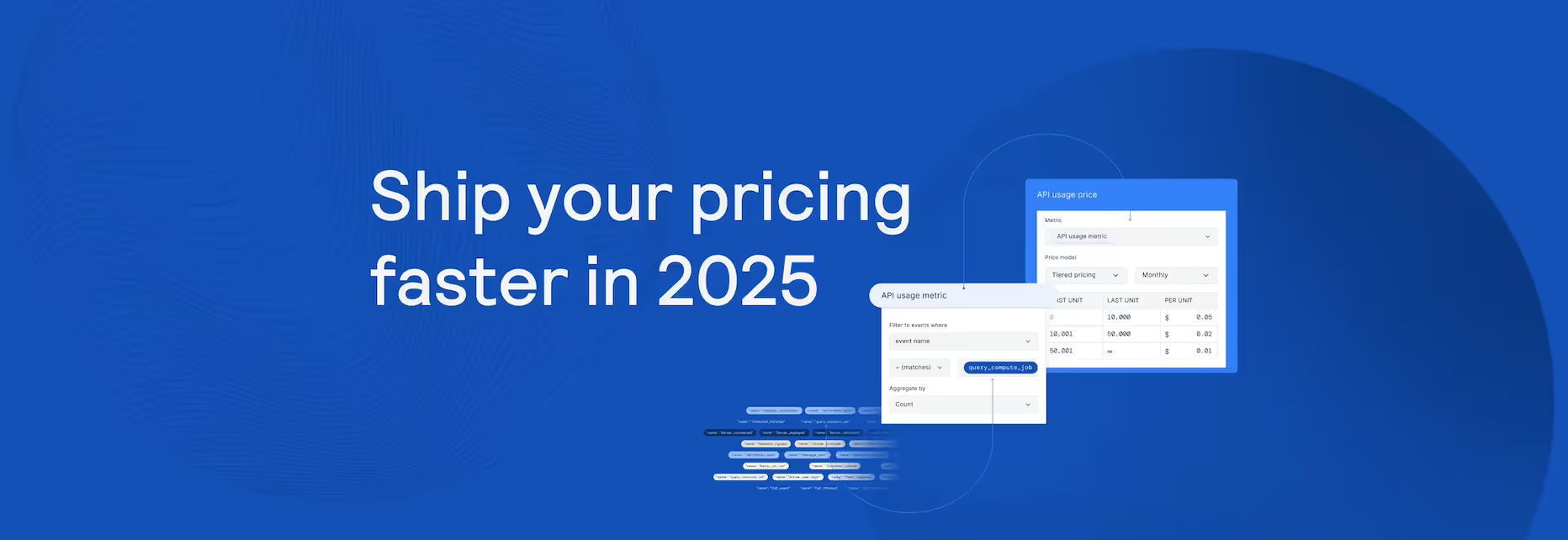2023 has been marked by the explosive growth and adoption of GenAI, and industry leaders are feeling the pressure to innovate rapidly. These latest trends have driven growth in the adoption of usage-based pricing models given how well they reflect the underlying infrastructure costs of these tools.
It’s become clear that legacy billing systems just haven't kept up with these innovations. Product and engineering leaders are faced with the challenge of shipping products on time while adjusting billing systems to power granular data needed to adopt usage-based pricing models. If you’re up against ambitious timelines to ship new products next year, read on for three billing best practices to help you launch on time without compromising your monetization vision.
1. Add pricing and billing requirements in your product spec early
Pricing considerations are often an afterthought in the product development process, leading to bottlenecks that slow down launches. This delay stems from two primary issues. Firstly, products may not be built to support usage-based pricing. When this is the case, engineering teams find themselves deciphering legacy technical infrastructures and modifying them to align with consumption-based pricing, diverting focus from the core product or feature development.
This then leads to the painful dilemma: should you delay the launch or should you compromise on the pricing strategy? Internal billing system development can extend up to six months, prompting companies to compromise on product features to meet launch deadlines. Developing pricing and billing requirements into the product spec helps teams get and stay ahead of these potential roadblocks.
Take the example of Replit, a team that is on a mission to bring the next billion software creators online. During the planning process for Autoscale, the Replit team recognized potential delays in building an internal billing system and decided to adopt Orb. As a result, they successfully launched on time. Jeremy, Replit’s Product Engineering Manager, attested to the impact of the decision: "Orb made our Autoscale launch possible by making pricing changes easy and stress-free up until the last minute."
2. Make monetization a part of the user experience design
Monetization can make or break product revenue and user experience. When implementing new pricing, a common challenge is the surge in customer support tickets from questions about how the end-of-the-month bill was calculated. Orb addresses this with a native invoice that connects usage events, pricing, and the final invoice amount.
Price changes can feel sensitive to customers. A well-timed message can mitigate any negative sentiment and even allow teams to seize potential upsell opportunities. For example, Replit uses Orb’s usage alerts to notify their teams when users hit cost thresholds, offering insights into user spend and payment. They also use webhooks to help prevent payment failures, empowering their customers to manage usage in real-time and Replit to stay ahead of surprises.
3. Prepare GTM and finance teams for a new pricing model
Introducing a new pricing model is a collaborative effort involving various teams. Engage cross-functional teams early to identify education needs and assess existing financial systems and processes for a seamless transition.
To help cross-functional partners efficiently, empower both your customer-facing and finance teams with a single source of truth. Consistent real-time usage and pricing data enable these teams to make evidence-based decisions instead of trying to close data gaps.
For the Marketing, Sales, and Customer Success teams, develop detailed guides and training sessions to effectively communicate and implement pricing changes. Sales and customer success teams play a pivotal role in the experience guiding customers to the pricing tier that best fits their usage. Leaders can equip their sales teams with real-time usage and billing data to help them pitch to customers strategically and even proactively reach out to customers who may benefit from a different plan by using Orb’s salesforce integrations.
In terms of financial processes, the changes required differ depending on the types of pricing models offered. For example, if your company is implementing prepaid credits, collaborate with finance to establish robust reporting capabilities, ensuring accurate tracking of revenue. You can learn how to implement prepaid credits here, or use Orb's prepaid credit ledger that automatically keeps track of prepaid credits and account balances.
Product engineering leaders need solutions to overcome the innovation challenges and get ahead of the competition - fast. Whether you opt to implement an internal solution or leverage external tools, the overarching strategy is to ensure that your pricing strategy aligns with your product and customer experience and propel you forward to realize your vision for next year.



